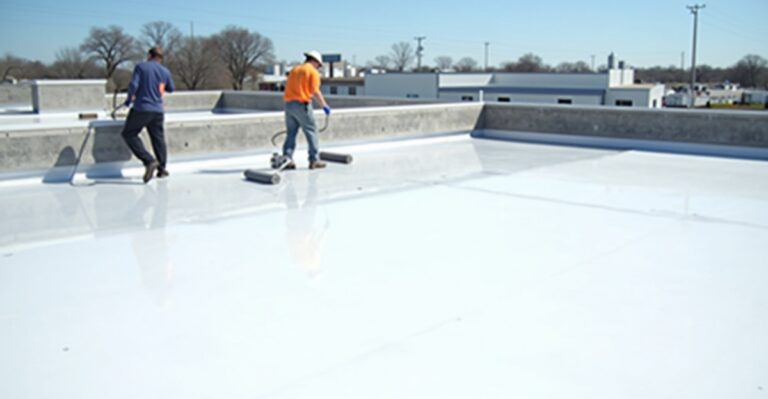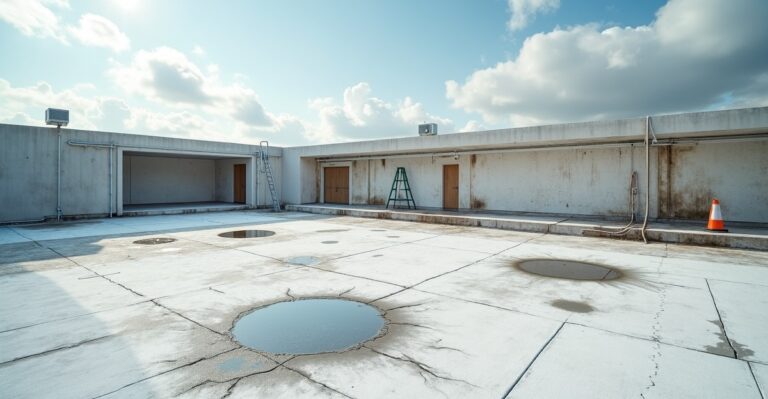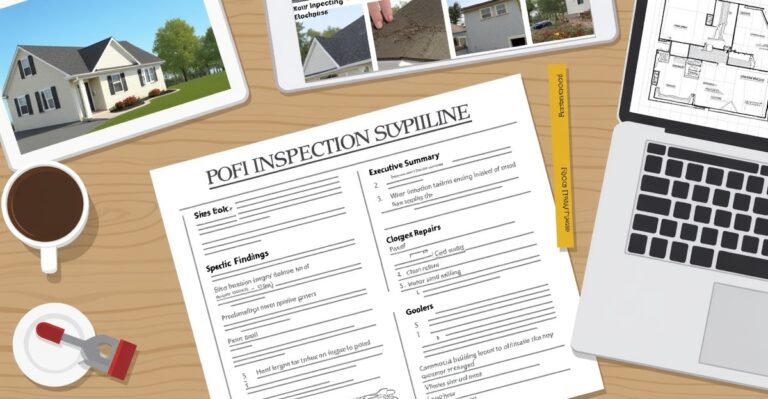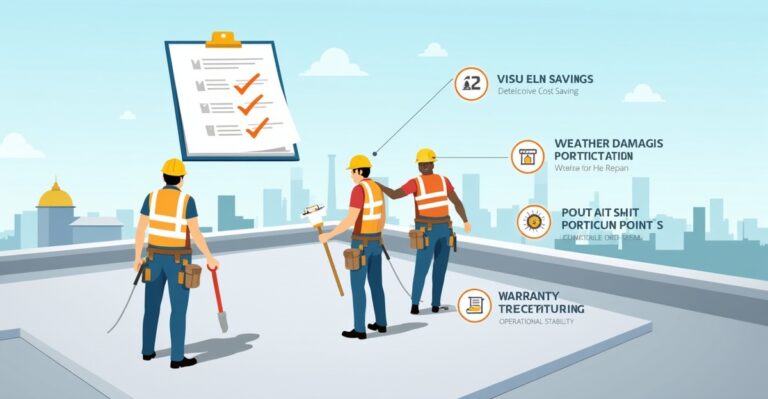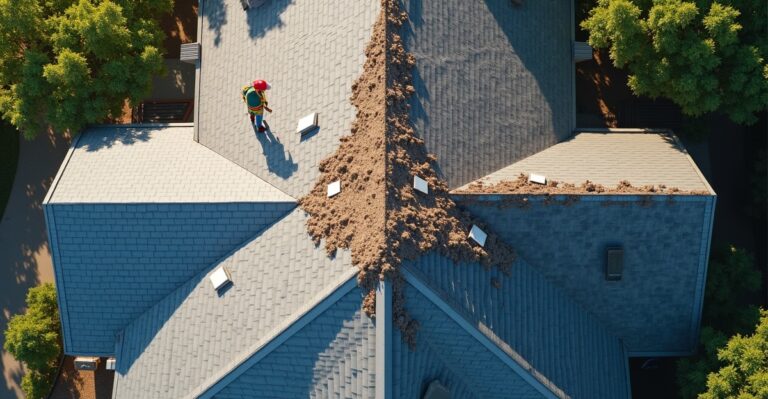How to Remove Moss from Roof: Safe & Effective Methods

Moss on your roof might seem like a small issue—but left untreated, it can cause serious damage and shorten your roof’s lifespan. In this guide, we’ll walk you through how to remove moss from roof surfaces safely and effectively, whether you’re a homeowner tackling a DIY job or a property manager considering professional help.
You’ll learn why moss is more than just an eyesore, how to spot the early signs of damage, and what tools and methods work best. We’ll also share expert-backed roof moss removal tips to prevent it from coming back—and help you decide when it’s time to call in a trusted contractor like RayPro.
Here’s what we’ll cover:
- Why Moss on Your Roof Is More Than Just an Eyesore
- Signs Your Roof Has a Moss Problem
- Moss Removal Methods: DIY vs. Professional Options
- Best Tools and Products for Moss Removal
- How to Prevent Moss from Coming Back
- When and How Often Should You Remove Moss from Your Roof
- Conclusion: Protect Your Roof with Smart Moss Removal & Trusted Help
Let’s start by looking at why moss is more than just a cosmetic concern.

Why Moss on Your Roof Is More Than Just an Eyesore
At first glance, moss on your roof might seem harmless—maybe even quaint. But that green, fuzzy growth is doing more damage than you think. Moss traps moisture against the surface of your shingles, creating the perfect environment for decay and deterioration. Over time, this excess moisture can lead to rot, loosened shingles, and even leaks that affect the structure underneath.
To understand how moss takes hold and harms your roof over time, check out this helpful guide on how moss grows and damages your roof.
One of the most overlooked dangers is how moss compromises the integrity of your roofing system. As it spreads, moss can lift shingles slightly, allowing water to seep in. This may not cause an immediate leak, but it does create a long-term moisture retention problem—one that gradually softens wood decking, corrodes nails, and weakens flashing. Left untreated, that moisture can work its way into your attic insulation, ceilings, or walls, resulting in expensive repairs and potential mold issues.
In commercial or multi-unit properties, the impact can be even greater, often requiring specialized commercial roof moss treatment. Moss growth on flat or low-slope roofs may interfere with drainage systems, causing standing water and increasing the risk of pooling and leaks—issues that not only damage the building but also disrupt operations and tenant satisfaction.
So, why is moss bad for your roof? Because it’s not just cosmetic—it accelerates wear and tear, invites water damage, and shortens the life of your investment. And yes, moss can be dangerous to your roof structure, especially if ignored over time.
Key takeaway: Moss might grow slowly, but the damage it causes doesn’t wait. Addressing it early helps preserve your roof’s integrity, avoids costly repairs, and extends the lifespan of your property—whether it’s your family home or a commercial asset.

Signs Your Roof Has a Moss Problem
Catching moss early can save you thousands in roof repairs. But because moss tends to grow slowly, many homeowners and property managers don’t realize there’s a problem until visible damage appears. Knowing the signs of moss damage—from mild to severe—can help you act before the issue spreads.
Here’s what to watch for:
1. Green or Dark Patches on the Roof
The most obvious sign is visual. If you notice fuzzy green patches or dark streaks forming on shaded areas of your roof, that’s likely moss or algae. It often starts in spots with poor sunlight exposure or near overhanging trees.
2. Curled or Lifting Shingles
As moss grows between shingles, it pushes them upward, weakening their seal and making them more vulnerable to wind and water. This curling can also expose the underlayment to the elements.
3. Granule Loss
If you’re finding asphalt granules in your gutters or downspouts, moss could be part of the problem. Moss retains moisture that wears down the protective layer on asphalt shingles, leading to premature aging and deterioration.
4. Gutter Clogs or Overflow
Moss doesn’t just stay on the roof—it can break loose and clog your gutters, making it vital to understand how gutters protect your roof and property. Gutter cleaning and regular inspections can help prevent water from backing up under shingles.
5. Water Spots or Leaks Indoors
If moss has been thriving unchecked, it can eventually lead to roof moss and leaks. Stains on ceilings or walls, musty smells in the attic, or visible drips during rainstorms are late-stage indicators that moisture has penetrated your roofing system.
Key takeaway: Moss problems often start small—but the longer you wait, the worse the damage gets. Regular roof inspections can help you catch these warning signs early and prevent minor issues from turning into costly repairs.

Moss Removal Methods: DIY vs. Professional Options
Once you’ve identified a moss problem, the next step is choosing how to get rid of roof moss effectively and safely. Should you handle it yourself or bring in a professional? Both options have merit—but the right choice depends on your roof’s condition, your comfort with heights, and how extensive the moss growth is.
Below is a quick comparison of DIY vs. professional moss removal:
| Factor | DIY Moss Removal | Professional Moss Removal |
| Cost | Low to moderate (products, tools, time) | Higher upfront cost, but includes labor, equipment, and expertise |
| Effectiveness | Varies based on method and effort | Consistently effective with industry-grade solutions |
| Time | Can take several hours or days | Typically completed in a few hours |
| Safety | Ladder risk, potential for roof damage | Licensed, insured pros trained for roof safety |
| Long-Term Results | May need frequent reapplication | Often includes prevention measures |
DIY Moss Removal Options
If your roof is easily accessible and the moss growth is minor, DIY moss removal from shingles may be a reasonable short-term solution. However, it comes with a few caveats.
Natural Methods
Natural moss killers like vinegar, baking soda, or a mix of dish soap and water are popular among homeowners looking for the best way to remove moss from asphalt shingles. They’re environmentally friendly and relatively safe for nearby landscaping. Just be aware: they usually require repeat applications and may not fully kill deep-rooted moss.
Chemical Options
For tougher jobs, products containing zinc sulfate or diluted bleach can be effective. These are often considered among the best moss removers for roofs, especially when applied using a pump sprayer. That said, harsh chemicals can harm plants, corrode gutters, or void roofing warranties if misused—so read labels carefully and follow all safety instructions.
Pressure Washing Cautions
While it might seem like a quick fix, pressure washing roof moss can do more harm than good. High-pressure water can strip granules from asphalt shingles, damage seals, and force water underneath roofing layers. Use only low-pressure settings if absolutely necessary, and avoid altogether on older or delicate roofs.
Safety Gear & Ladder Risks
Any roof work involves risk, so knowing how to clean moss off roof safely is essential. Falls from ladders and slippery surfaces are a common cause of injury. Always use a sturdy extension ladder, wear rubber-soled shoes, and consider having a second person nearby to assist.
When to Hire a Roofing Contractor
Sometimes, the safest and smartest option is to bring in the pros—especially if:
- Your roof is steep, multi-level, or fragile
Navigating slopes increases fall risk and the chance of damaging your roof. - You’re concerned about warranties or insurance coverage
DIY treatments that use harsh chemicals or pressure washers could void warranties or complicate insurance claims. - You manage a commercial property or multiple locations
Large flat roofs, multi-family buildings, and commercial facilities require scalable solutions and careful scheduling to minimize disruptions. In these cases, commercial roof moss removal is best left to licensed professionals who understand the scope and safety requirements.
If your roof is steep, multi-level, or aging—or if you manage a commercial property—professional service is often safer and more effective. In fact, according to NRCA’s guidelines on roof repair and maintenance, ongoing care by licensed pros is one of the best ways to ensure long-term roof performance.
A trusted contractor like RayPro can not only remove the moss but also inspect for hidden damage, apply long-term prevention treatments, and ensure compliance with warranty and building codes. They also offer emergency roof repair when unexpected issues arise during inspections or treatment.
Key takeaway: DIY moss removal may be a short-term fix—but it carries risks. For lasting results and peace of mind, especially on larger or more complex roofs, professional help is often the better investment.

Best Tools and Products for Moss Removal
When it comes to effective moss cleaning for shingles, the right tools and products make all the difference. Whether you’re taking the DIY route or preparing for a professional to service your roof, using safe, effective materials ensures you get the job done without damaging your roof in the process.
Here’s a breakdown of commonly used products, what to avoid, and tips for getting the best results.
Recommended Tools and Products
| Tool/Product | Purpose | Notes & Tips |
| Pump Sprayer | Even application of moss treatment | Choose a sprayer with a long wand for reach and control |
| Long-Handled Soft Brush | Gently dislodge dead moss | Avoid stiff bristles that can strip shingle granules |
| Zinc Sulfate-Based Moss Killer | Chemical treatment to kill moss | Highly effective; use sparingly to avoid runoff damage |
| Vinegar or Baking Soda Mix | DIY roof moss treatment (natural) | Eco-friendly but may require multiple applications |
| Oxygen Bleach Solution | Cleans without harsh chemicals | Safer than chlorine bleach for roof and environment |
| Zinc or Copper Strips | Long-term prevention after cleaning | Install near ridge line to inhibit regrowth when rainwater activates the metal ions |
What to Avoid
- Wire Brushes or High-Pressure Washers
These may seem tough on moss—but they’re even tougher on your shingles. Abrasive tools and high-pressure water can permanently damage the roof surface and void warranties. - Chlorine Bleach
While effective at killing moss, it can cause premature aging of roofing materials and harm landscaping if not diluted and rinsed properly. - Unlabeled or Generic Cleaners
Always check for roof-safe labeling. Products not designed for asphalt shingles or roofing systems may cause more harm than good.
Tips for Proper Use
- Apply treatments on an overcast day when the roof is cool. This prevents product evaporation before it has time to work.
- Let the moss killer sit according to label directions—usually 15–30 minutes—before rinsing or brushing.
- Always work from the top of the roof downward to avoid forcing water under shingles.
- Use protective gear (gloves, goggles, non-slip shoes) and follow all safety precautions.
Key takeaway: The best moss remover for roofs is one that balances effectiveness, safety, and roof compatibility. Avoid shortcuts like wire brushes or harsh chemicals, and use proven tools and treatments designed specifically for roofing applications.

How to Prevent Moss from Coming Back
Removing moss is only half the battle—the real win is keeping it from coming back. Roofs in humid, shaded, or tree-covered areas are especially prone to regrowth, which means prevention should be part of your regular roof maintenance routine.
Here are proven strategies for how to prevent moss on your roof long term:
1. Install Zinc or Copper Strips
These metal strips are one of the most effective passive prevention tools. When rainwater flows over zinc or copper, it releases trace elements that inhibit moss growth. Installed just below the ridge line, they create a protective barrier across the roof as water runs down.
2. Trim Overhanging Trees and Branches
Moss thrives in damp, shaded environments. Trimming trees back from your roof improves sunlight exposure and airflow—making your roof less inviting to moss, algae, and mildew.
3. Improve Roof Ventilation
Good attic ventilation helps regulate temperature and moisture, reducing the damp conditions moss loves. If your attic tends to be humid or stuffy, it may be worth evaluating your ventilation setup as part of an overall how to maintain roof health plan.
4. Keep the Roof Clean of Debris
Leaves, pine needles, and other organic matter trap moisture and give moss a foothold. Use a roof-safe leaf blower or soft broom to clear off debris, especially in valleys or around skylights.
5. Perform Seasonal Inspections and Cleaning
Regular inspections—at least once in the spring and fall—can catch early signs of moss or buildup. After storms, make sure to check for pooling water or clogged gutters that can increase moisture retention on the roof.
Roof Moss Prevention Checklist
- Install zinc or copper strips
- Trim nearby trees and branches
- Check attic and roof ventilation
- Clear off organic debris regularly
- Schedule seasonal roof inspections
- Clean gutters to ensure proper drainage
- Reapply moss treatment annually if needed
Key takeaway: Preventing moss is easier and more cost-effective than removing it year after year. By staying proactive with these simple maintenance steps, you can protect your investment and extend your roof’s lifespan—no matter the climate.

When and How Often Should You Remove Moss from Your Roof?
Knowing how often to clean roof moss can help you stay ahead of damage and avoid costly repairs down the road. The right cleaning schedule depends on several factors—like your local climate, the type of roofing material you have, and how much shade or debris collects on your roof.
Inspect your roof at least twice a year. Frequency depends on region and roof type. For example:
- In Florida, consider local standards like the 15-Year Roof Rule, which can influence insurance and replacement decisions.
- In the Pacific Northwest, high humidity calls for more frequent cleaning.
- For tile roofs, watch for growth between joints.
- Metal roofing resists moss, but still needs debris checks.
If moss buildup has already led to structural concerns, a roof safety assessment can help determine the urgency of professional intervention.
General Inspection & Cleaning Guidelines
As a rule of thumb, inspect your roof at least twice a year—once in the spring and once in the fall. These seasonal check-ins are a smart part of any property maintenance checklist and give you a chance to spot early signs of moss or other wear.
If you live in a region with high humidity, frequent storms, or dense tree cover, you may need to inspect—and clean—more often.
Recommended Schedule by Region
| Region | Inspection Frequency | Cleaning Needs |
| Florida & Gulf States | 2–3 times/year | High humidity = frequent moss growth. Inspect after rainy seasons and hurricanes. |
| Pacific Northwest | 2–4 times/year | Shady, damp conditions are ideal for moss. Clean at least annually. |
| Northeast/Midwest | 2 times/year | Watch for buildup after winter snowmelt and fall leaf drop. |
| Southwest/Dry Climates | 1–2 times/year | Moss is less common, but debris and dust buildup can still cause issues. |
Roof Type Considerations
- Asphalt Shingles: Prone to granule loss if moss takes hold. Clean annually in high-risk areas.
- Tile Roofs: Durable but moss can grow between joints—check out how to care for tile roofing to avoid premature wear.
- Metal Roofs: Less moss-friendly, but still check shaded or debris-heavy areas.
Post-Storm & Post-Winter Checks
Severe weather can dislodge moss or debris and cause drainage issues. Always inspect your roof after:
- Hurricanes or tropical storms
- Heavy rainfall or flooding
- Ice or snow accumulation (in colder states)
Key takeaway: There’s no one-size-fits-all answer for moss removal timing. But staying consistent with seasonal inspections—and adjusting based on your region—will help you catch growth early and keep your roof in top condition year-round.

Conclusion: Protect Your Roof with Smart Moss Removal & Trusted Help
Moss might start as a minor nuisance, but if left unchecked, it can cause serious damage to your roof—and your property’s value. Whether you opt for a careful DIY roof moss treatment or call in a pro, the most important step is taking action before small patches turn into structural problems.
We’ve covered the risks moss poses, how to spot early warning signs, the best tools and removal methods, and what you can do to keep it from coming back. If your roof is steep, aging, or part of a commercial property, hiring a professional isn’t just safer—it’s smarter.
At RayPro Roofing & General Contracting, we combine over 17 years of roofing experience with a reputation built on trust, quality, and full-service care. From moss removal to long-term maintenance, our licensed professionals provide honest guidance, thorough inspections, and reliable solutions tailored to your property.
Need expert help? Contact us for a free roof inspection and honest quote—no pressure, just smart solutions. Let’s protect your investment and keep your roof in peak condition year-round.
Frequently Asked Questions (FAQs)
The best moss remover depends on your roof type and personal preference. Zinc sulfate-based treatments are highly effective and commonly used by professionals. For a more eco-friendly option, oxygen bleach or a mix of vinegar and water can work on smaller areas. Always choose products labeled as roof-safe to avoid damage to shingles or nearby landscaping.
It’s not recommended. Pressure washing can strip away the protective granules on asphalt shingles and force water under the roofing layers, leading to leaks. If you must use water, opt for a low-pressure rinse and never aim upward against the slope. For most roofs, soft brushing combined with a proper moss treatment is a safer alternative.
Prevent moss by keeping your roof clear of debris, trimming overhanging branches, and ensuring good attic ventilation. Installing zinc or copper strips along the roof ridge can also help—when it rains, these metals release ions that inhibit moss growth. Regular inspections and seasonal cleaning go a long way toward keeping your roof moss-free.
Typically, no—moss buildup is considered a maintenance issue rather than sudden or accidental damage. However, if moss causes significant water damage or leaks that lead to structural issues, you may have some coverage. It’s best to check with your insurance provider for specifics.
Hire a pro if your roof is steep, fragile, multi-story, or showing signs of serious damage. Commercial properties or large multi-family buildings also require specialized care. A professional roofing contractor like RayPro can remove moss safely, inspect for hidden damage, and apply long-term prevention—all while protecting your warranty and property investment.

